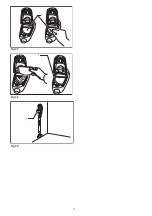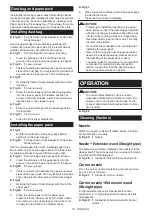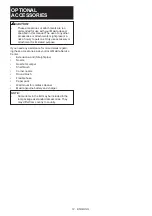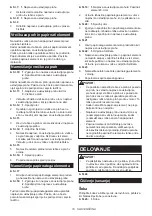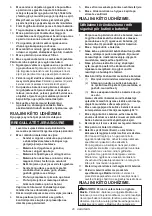
10 ENGLISH
Dust bag and paper pack
Install either dust bag or paper pack before using cleaner.
Use the dust stopper when installing either dust bag or paper pack.
The dust bag can be used repeatedly by cleaning it out.
Paper pack is a throw-away type. Throw away the entire
paper pack without emptying when it has become full.
Installing dust bag
►
Fig.10:
1.
Upper side of dust stopper
2.
Lower side
of dust stopper
Use the dust stopper when installing dust bag. Be
careful not to take the upper side for the lower side by
mistake because they are different each other.
►
Fig.11:
1.
Dust stopper
2.
Groove
3.
Dust bag
1.
Insert the protrusion of the dust bag into the
groove in the dust stopper as shown in the figure.
►
Fig.12:
1.
Lower groove
2. There is no distinction between the upper and lower
sides of the dust bag. You may insert its protrusion of
any side into the lower groove of the dust stopper.
►
Fig.13
3.
Overlap the frame of dust stopper with that of the
dust bag.
►
Fig.14:
1.
Cleaner cavity
4.
Place the dust stopper and the dust bag together
into the cleaner cavity in the same direction of
arrow on the dust stopper. Insert them all the way
into the slots in the cleaner cavity.
►
Fig.15
5.
Place the entire cloth part of the dust bag inside
the tool itself.
►
Fig.16:
1.
Front cover
6.
Close the front cover completely.
Installing the paper pack
►
Fig.17
1.
Unfold the entrance of the paper pack before
setting it on the dust stopper.
►
Fig.18:
1.
Upper side of dust stopper
2.
Lower side
of dust stopper
Use the dust stopper also when installing paper pack.
Be careful not to take the upper side for the lower side
by mistake because they are different each other.
►
Fig.19:
1.
Dust stopper
2.
Paper pack
3.
Groove
2.
Insert the protrusion of the paper pack into the
groove in the dust stopper as shown in the figure.
►
Fig.20:
1.
Lower groove
3. There is no distinction between the upper and lower
sides of the paper pack. You may insert its protrusion
of any side into the lower groove of the dust stopper.
►
Fig.21
4.
Overlap the frame of dust stopper with that of the
paper pack.
►
Fig.22:
1.
Cleaner cavity
5.
Place the dust stopper and the paper pack
together into the cleaner cavity in the same direc-
tion of arrow on the dust stopper. Insert them all
the way into the slots in the cleaner cavity.
►
Fig.23
6.
Place the entire container part of the paper pack
inside the tool itself.
7.
Close the front cover completely.
CAUTION:
•
Forgetting to install the dust bag or the paper
pack, failure to insert the dust stopper together
with the dust bag or the paper pack all the way
into the slots or using a broken or ripped bag,
may allow dust to get into the motor. This may
result in motor failure.
•
Do not fold the cardboard at its opening when
installing the paper pack.
•
Never throw away the dust stopper because it
needs to be used repeatedly whenever either
the dust bag or the paper pack is used.
•
The paper pack for the cleaner is an important
component for maintaining the tool perfor-
mance. Using other than the genuine paper
pack may cause smokes or ignition.
OPERATION
CAUTION:
•
To connect attachments, such as nozzle,
twist-insert attachment in direction of arrow to
ensure secure connection during use. To dis-
connect attachment, twist-extract also in direc-
tion of arrow.
►
Fig.24
Cleaning (Suction)
Nozzle
Attach the nozzle to clean off tables, desks, furniture,
etc. Nozzle slips on easily.
►
Fig.25:
1.
Nozzle
Extension wand (Straight pipe)
The extension wand fits in between the nozzle and the
cleaner itself. This arrangement is convenient for clean-
ing a floor while standing erect.
►
Fig.26:
1.
Cleaner
2.
Nozzle
3.
Extension wand
Corner nozzle
Fit on the corner nozzle for cleaning corners and crev-
ices of a car or furniture.
►
Fig.27:
1.
Cleaner
2.
Corner nozzle
Corner Extension wand
(Straight pipe)
In tight quarters where the cleaner itself cannot
squeeze in, or in high places hard to reach, use this
arrangement.
►
Fig.28:
1.
Cleaner
2.
Extension wand
3.
Corner
nozzle
Summary of Contents for CL072D
Page 2: ...1 2 1 2 1 2 1 1 2 1 2 1 1 Fig 1 Fig 2 Fig 3 Fig 4 Fig 5 Fig 6 Fig 7 Fig 8 2 ...
Page 3: ...1 2 1 2 3 1 1 1 Fig 9 Fig 10 Fig 11 Fig 12 Fig 13 Fig 14 Fig 15 Fig 16 3 ...
Page 4: ...1 2 1 2 3 1 1 Fig 17 Fig 18 Fig 19 Fig 20 Fig 21 Fig 22 Fig 23 Fig 24 4 ...
Page 5: ...1 1 2 3 1 2 1 2 3 Fig 29 Fig 25 Fig 26 Fig 27 Fig 28 Fig 30 Fig 31 Fig 32 5 ...






